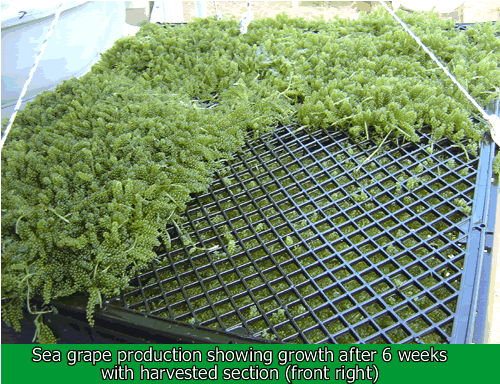
Summary of final report on the Australian Flora Foundation funded project:
Nicholas A. Paul 1*, Symon A. Dworjanyn2, Rocky de Nys1
1 School of Marine and Tropical Biology, James Cook University, Townsville 4811
2 National Marine Science Centre, Southern Cross University PO Box 4321 Coffs Harbour
10 April 2013
This research project describes the first detailed and simultaneous examination of the aquaculture production and nutritional values of edible seaweeds in Australia. “Sea grapes” is a collective term for the edible varieties of the green seaweed genus Caulerpa that are harvested and consumed fresh in nations throughout the Pacific. These species are also present throughout Australia. However, only one species (Caulerpa lentillifera) is in aquaculture production in Japan and SE Asia, and it is unclear, to date, whether other seagrapes can also be domesticated or have comparable nutritional value.
Here we conduct comparative analyses of biomass productivity and nutritional composition of C. lentillifera (“green caviar”) and C. racemosa var. laetevirens from tropical Australia. We focused exclusively on these species for the empirical components as we found that other common varieties of sea grapes from the tropics (C. racemosa var. racemosa, Townsville) and sub-tropics (C. geminate & C. sedoides, Coffs Harbour) were not suited to aquaculture production via vegetative propagation. Commercial-scale production was evaluated using 1 m2 (5 cm deep) culture units developed for vegetative propagation of C. lentillifera. This system operates at high stocking densities (>5 kg m-2) and harvestable biomass protrudes through the top of the unit. Productivity of C. lentillifera in a 6 week cycle yielded, on average, 2 kg FW week-1 and retained 6 kg m-2 stock within the unit. However, over two consecutive 3 week culture cycles C. racemosa yielded <0.5 kg week-1 of new growth above
the unit, which did not compensate for loss of stock within the unit on both occasions (total biomass losses of up to 1.3 kg week-1). Morphometric comparisons of the harvestable biomass revealed that C. lentillifera had a higher proportion of fronds to roots (68% vs. 48%), at a greater density per unit area (50 vs. 30 fronds cm-2). C. racemosa fronds were
significantly longer (6 cm vs. 3 cm), and therefore suited to a shorter culture cycle.
The nutritional value of the fronds (omega-3 & 6 fatty acids, antioxidant pigments and trace elements) was generally higher in C. racemosa. C. racemosa had higher unsaturated fatty acid contents (12 vs. 6 mg g-1 DW) and a slightly better ratio of omega-3: omega-6 (2 vs. 1.5). Trace elements varied substantially between the species (2 to 100-times), including higher levels in C. lentillifera of zinc (27.55 vs. 0.08 ppm), magnesium (16,650 vs. 4,115 ppm) and strontium (143 vs 0.16 ppm) and higher levels in C. racemosa of selenium (124.0 vs. 3.9 ppm). Some less desirable elements were higher in C. lentillifera, for example, arsenic (1 vs 0.1 ppm) and cadmium (0.53 vs. <0.05 ppm), whereas others were higher in C. racemosa including lead (4.45 vs. 0.16ppm), copper (7.19 vs. 0.89 ppm) and vanadium (10.14 vs. 0.44 ppm). C. racemosa had ~2 times the antioxidant content (chlorophyll a & b, ß – carotene; 100 vs. 50 mg g-1 FW).
Overall C. lentillifera has high production rates and therefore warrants commercialisation as a new aquaculture product in Australia. On the other hand C. racemosa has many nutritional traits and some growth traits (e.g. frond length) that indicate potential for commercial production or alternatively for aquaculture ranching using wild harvests as a seedstock. The two species are both viable options for the establishment of a high-value, edible seaweed industry in Australia, which may be complimented by other sea grapes from the diverse genus of Caulerpa that can be found on all coastlines.
